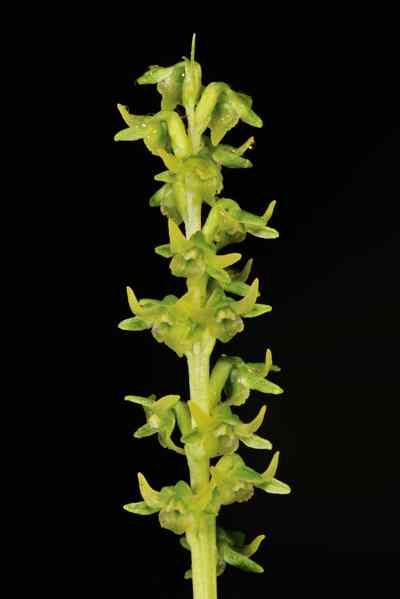The Plant
Terrestrial. Whole plant 10 to 16 cm in height. Tuber globular, small, two or three long roots arising from the base of the stem. Stem cylindrical, more than half the height of the plant, with a loose tubular sheath at its base and a narrow long, linear, erect bract around its apex. Leaf two or three, unequal, closely arranged and arising a little above the base sheath, elliptic, veined, narrowed at the base to a long tubular sheath, 3 to 5 cm long and around 1.5 cm in width. Flower many, arranged closely in a ribbed spike shorter than its stem.
The Flower
Flower 1.5 cm across. Sepals unequal; dorsal ovate with broad base, diagonally erect; lateral pair longer than the dorsal, linear to oblong, spreading, with margins curved up, both one veined. Petals longer than the sepals, lanceolate, diagonally erect and it apex bend backwards. Lip as long as the lateral sepal, pointing downward, broadly ovate, with small-clawed side lobes. Floral bract erect and less than one third the size of the erect ovary, lanceolate, and arising from the lower base of the ovary.
Sepals pale green with a dark broad vein along its middle. Petals and lip greenish yellow. Floral bract pale green.

The Pursuit
I found many documented evidences of this species from various publications. Hence, I was of the opinion that I will be able to find out this species without much difficulty. But my calculations’ went totally wrong, as I was not able to locate the species in the first year of my alpine work.
In the second year, I concentrated on areas where I had seldom visited the previous year. I worked very well and was able to locate many new species as well as new habitats of species I found earlier. Then too this species remained elusive. The mention of its blooming months in the referral work was June/July. Hence, I made my survey plans for this species by the mid of May on various locations, mainly on open slopes.
Every day it rained heavily on those altitudes and travel and survey was very hard. However, I kept a practice to continue with my survey uninterrupted every day irrespective of rains or sunshine. Most of the days we received heavy showers and I moved around in raincoats. The raincoat got a hood, which covers the whole head. Even though it helps in keeping my body dry, the survey was not comfortable as the hood disturbs proper visibility especially to the sides. Hence, my view was concentrated on to the center only. The narrow view coupled with heavy rains might have taken many species out of my sight. Finally, on a heavy raining day, as it was destined for me, I found this species from a bushy area. There were a total of seven plants, with most of the flowers in bloom as well as withered.
The find was also interesting. As I was searching an open area, there was a small animal, almost the size of a rat, which swiftly moved across the plains. As the visibility was poor I was not able to identify the animal and ran behind it to have a closer look. It ran inside those bushes and hid inside. I knew after some time it will surely come out and I would be able to identify it. As I was waiting there silently, I spotted a few ground orchids. As the animal took its own time, my attention moved to those orchids. On a closer look I was surprised to identify those small plants I found was that of this species. This species find made me abandon the wait for the small creature and rushed to those plants. It was such a joyous moment to see the plants considered common but which eluded me.
It was raining heavily and the flowers were also not so fresh. With much difficulty in those windy and raining conditions I made drawings and documented the plants. But, for reasons I cannot explain, I was not satisfied with those documentary results. However, even after two more seasons of work in the alpine region, this “common” plant remained elusive for me. Unfortunately, I was not able to visit the same location again in my later years. If had visited its habitat again I would have got the flowers fresh and also would able to document them on a sunny day!!!
Reference:
King, G. &Pantling, R. (1898). The Orchids of the Sikkim-Himalayas. Ann. Roy. Bot. Garden. (Calcutta). Herminium josephi Reichb. Pg. no. 335 – 336.